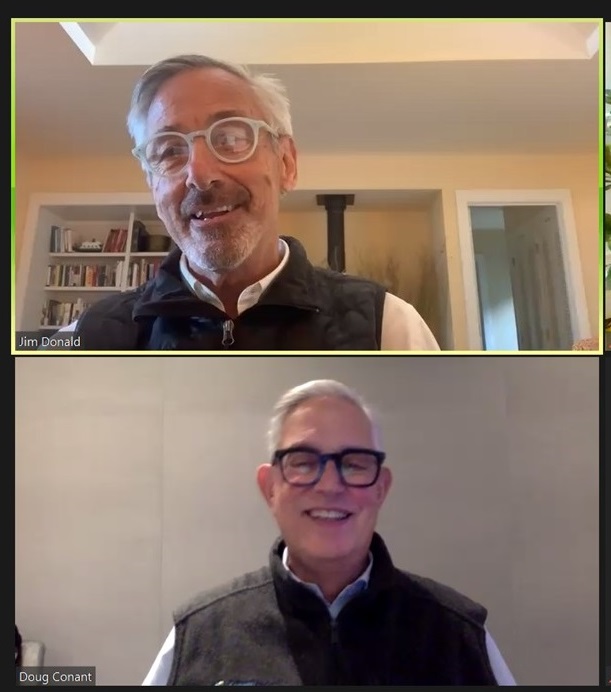
 At ConantLeadership’s recent BLUEPRINT Leadership Summit—a virtual meeting of the top minds in leadership—Jim Donald (co-chair and former president and CEO of Albertsons Companies) spoke with Doug Conant (founder of ConantLeadership, former CEO of Campbell Soup Company, and bestselling author of The Blueprint and TouchPoints) about how to build highly engaged teams that drive record growth.
At ConantLeadership’s recent BLUEPRINT Leadership Summit—a virtual meeting of the top minds in leadership—Jim Donald (co-chair and former president and CEO of Albertsons Companies) spoke with Doug Conant (founder of ConantLeadership, former CEO of Campbell Soup Company, and bestselling author of The Blueprint and TouchPoints) about how to build highly engaged teams that drive record growth.
Enjoy the following tips and takeaways from their conversation in the recap below. You can also watch the recording of their discussion (skip to roughly minute 8 to skip intros and housekeeping).
Your Employees Are Your Best Teachers
Both panelists share deep experience in the food and grocery industries—Doug Conant at Nabisco Foods Company, Campbell Soup Company, Kraft, and others; and Jim Donald at Albertsons, Walmart, Starbucks, and more. This industry connection prompts them to bond over their mutual respect for the late Sam Walton, the founder of Walmart known for his commitment to leadership through service. Both panelists cite Walton’s integrity and leadership style as a profound inspiration on their respective journeys.
Conant says Walton “set the tone for the way I’ve chosen to walk in the world . . . in terms of leading people and getting them engaged.” He says Walton’s “people-first” leadership approach taught him to meet employees where they are and “show them what’s possible.”
Donald, who worked with Walton personally at Walmart, says he learned countless lessons from him about how to create highly engaged teams. He shares the advice Walton gave him more than three decades ago—wisdom that continues to shape his leadership story today: “Never be bigger than the front line. Never. If you’re bigger or better than the front line, your personal and business legacy will be in tatters.”
In other words, have the courage to turn hierarchies on their head: When leaders are in a foundational position of support and service, employees become more elevated and engaged, and the entire organizational ecosystem thrives.
Conant is aligned with this idea of flipping the organizational chart upside down, encouraging leaders to consider employees first, with his oft-quoted advice that “to win in the marketplace, you must first win in the workplace.”
What’s especially compelling for today’s leaders is that the data is finally catching up. In Deloitte’s 2024 Global Human Capital Trends report, 74% of professionals confirm that it’s critical to measure worker performance and value beyond traditional productivity. The research firm refers to this concept as human sustainability, expounding on the idea that leaders “must focus less on how much people benefit their organization and more on how much their organization benefits people.”
Mutual support is the secret sauce.
Increasingly, the data shows that a win for employees is a win all around. And part of putting this into practice is understanding that the frontline has lessons for the C-Suite. Donald says of his employees: “They’re actually the teachers, not me.” Over the course of his career, spanning decades, he’s kept a diary of everything he’s learned from more than 500,000 employees—a clear example of why he’s been named one of the Top 25 CEOs in the World by The Best Practice Institute. He shares his top five lessons gleaned from the people he works with.
1. Care abundantly. Take the time to get to know your employees: Their names, their stories, and what they deal with every day. People are far more interested in how much you care than how much you know. (Just be sure to protect yourself from empathy fatigue by staying centered.)
2. Let people make decisions. When Donald was appointed CEO of Extended Stay America in 2012, the company was still recovering from bankruptcy. That first year, he gave out thousands of “get out of jail free” cards to provide Extended Stay employees with the autonomy to make one decision that could help turn the business around. It worked. Less than two years later, the company went public with an IPO of $565 million. “People don’t want to be a head count. They want their heads to count,” he shares.
3. Make heroes out of your employees. During Donald’s tenure as CEO of Starbucks, there was a crisis when the company was $150 million short of projections. After a cascade of fruitless attempts to “find the money,” it was supply-chain leader Dorothy Kim who figured out that the company was unintentionally overfilling each coffee bag by 15 beans. Remarkably, Kim’s discovery cut the issue in half, resolving $70 million. The entire company celebrated the win, and it sparked positive change, with $600 million in savings the following year. “Celebrate the success of others. You’re going to be surprised just how fast sales can ramp up,” encourages Donald.
4. Be a different kind of bilingual. The greatest leaders are fluent in the languages of both the head and the heart. Donald says that when employees feel “emotionally connected to the business,” it’s often because their leader has an EQ that matches their IQ. This echoes Conant’s oft-quoted philosophy that leaders must be “both tough-minded on standards and tender-hearted with people.”
5. Build and use your “street cred.” People want to know that you’ve been around the block a few times, that you can humbly meet them where they are, and relate to their experiences, instead of issuing directives from a pedestal. Donald points out that your employees have “street cred like you wouldn’t believe.” Make sure you learn from them.
If You’re the Smartest Person in the Room, You’re in the Wrong Room
Conant agrees with Donald that CEOs must listen and learn from the people in their organization. He says “leading by listening” is a central theme of earning trust—and that trust is essential to building highly engaged teams. If people “don’t trust you and don’t believe you have a genuine concern for their well-being, you’re dead on arrival,” he says.
When Conant took over as CEO of Campbell Soup Company in 2001, he was tasked with revitalizing the company’s faltering financial performance while also reversing a culture of low engagement. To fulfill his mandate as turnaround CEO, he had to build trust, and find people with the “competence and character” to be “wildly engaged in the enterprise.” And once he built trust, he gave others the reigns so that “they decided how to execute, not me.” Under his leadership, Campbell rose to the top tier of the global food industry in both culture and performance.
“Maybe, just maybe, nice is a strength.”
Both panelists say driving high performance and employee engagement is contingent on humility, on acknowledging that everyone in the organization has valuable input to share. In this spirit, Donald offers four “golden nugget tips” for building trust and engagement.
- If you’re the smartest person in the room, you’re in the wrong room. “You have got to be able to engage with people. Hire people that want to debate you, that aren’t going to agree with everything that you talk about.”
- Hire people who are smarter than you. “Pay them well [and] get out of their way.”
- Don’t expect to have all the answers. “It’s okay to sit back and listen.”
- Think of yourself as a chief execution officer or chief engagement “Your job as a leader is not to make the numbers dance . . . Your job as a leader is to make your people dance, who then make the numbers dance.”
Making “your people dance,” should not be like a puppet master pulling strings, clarifies Donald. It’s more akin to acting as a devoted choreographer who empowers others to take the stage and perform at their best. Then, the numbers follow the rhythm and progression to match.
Conant adds that if leaders want to build highly engaged teams, the curtain is rising right now. He says you must have “a sense of urgency” about promoting trust and showing genuine care. He credits his own understanding of these high stakes in helping him cultivate record high engagement among the teams he’s led: “They were smarter than I was. But nobody cared more than I cared. Nobody had their back like I had their back. And they were empowered to make decisions.” Mutual support is the secret sauce.
Nice Is a Strength
Earlier in their careers, both panelists were given constructive feedback that they were “too nice.” They were outliers in traditional corporate landscapes that valued the perceived bravado of an executive sequestered in their office. Their shared approach of putting people at the forefront of their leadership strategy sometimes puzzled the other leaders in their midst.
Donald shares one example from his tenure as a district manager for Albertsons: An executive approached his regional manager and said that Donald wouldn’t make it very far in the company because he was “too nice” for his own good. Like a true leader, the regional manager had his back and explained that it was Donald’s caring nature that had helped him successfully turn around 11 stores across the country.
“Maybe, just maybe, nice is a strength,” says Donald. And Conant, who has always said that, “in leadership, the ‘soft’ stuff is the ‘hard’ stuff,” agrees wholeheartedly. Neither panelist has ever accepted the idea that ‘tough’ and ‘nice’ are mutually exclusive. In fact, they say you must be both. So, to build highly engaged teams: Show people you care, learn from your employees, and lead by listening. You may be surprised just how far it takes you and your team.
____
Enjoyed These Insights?
Watch the full recording of this interview to get more details, including insights from an audience Q&A. You can also access the complete inventory of previous BLUEPRINT Leadership Summit sessions, including illuminating conversations with Brené Brown, Susan Cain, Indra Nooyi, Amy Edmondson, Bill George, Barbara Humpton, and many more.
Ready to Lift Your leadership to New Heights?
- Learn more about our signature leadership development course, The BLUEPRINT Boot Camp
- Join over 18k subscribers who receive our newsletter and leadership resources right in their inbox
- Check out our LinkedIn Learning course, “Finding Your Leadership Purpose with Doug Conant”
- Sign up to get updates about STEPS, our forthcoming leadership course for administrative professionals
- Get in touch to talk to us about a customized keynote speech, fireside chat, or course offering for your team
 About the Author: Vanessa Bradford is a freelance content writer and copywriter, and C3PR’s Content Marketing Director.
About the Author: Vanessa Bradford is a freelance content writer and copywriter, and C3PR’s Content Marketing Director.
(Cover photo by Memento Media on Unsplash)
Discover more from reviewer4you.com
Subscribe to get the latest posts to your email.





